Menus
- Japanese choppers in the test
- Kawasaki Vulcan S has 15 hp more
- Doubts about the mental health of the testers
- Passenger – knees under armpits and brace
- MOTORCYCLE test result
- Kawasaki Vulcan S and Honda Rebel 500 in price comparison
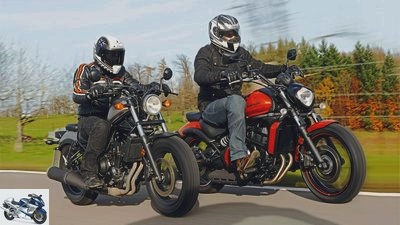
www.bilski-fotografie.de
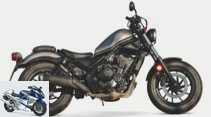
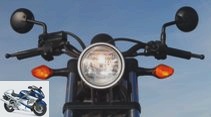
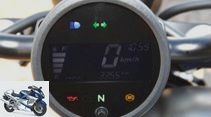
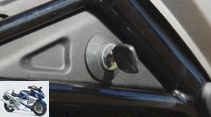
16 photos
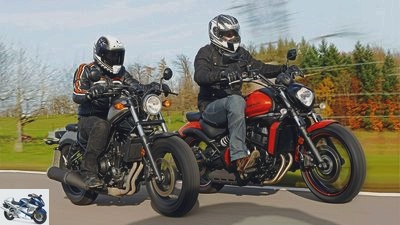
bilski-fotografie.de
1/16
The displacement dwarfs Kawasaki Vulcan S and Honda CMX 500 Rebel in comparison.
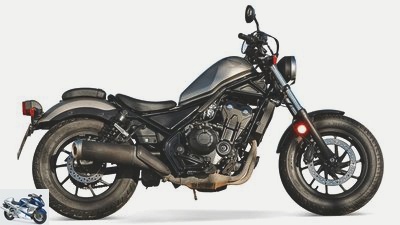
bilski-fotografie.de
2/16
Consumption on 100 km country road trip of the Honda: 3.7 liters.
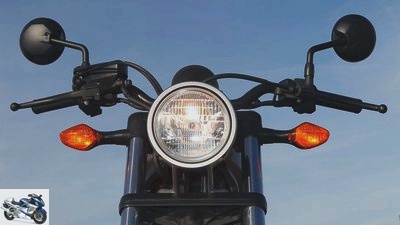
bilski-fotografie.de
3/16
The headlight of the Honda CMX 500 Rebel …
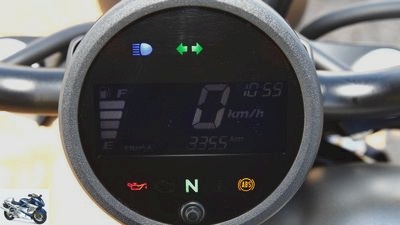
bilski-fotografie.de
4/16
…and the round instrument fit into the design concept. A gear indicator or a tachometer would have been nice.
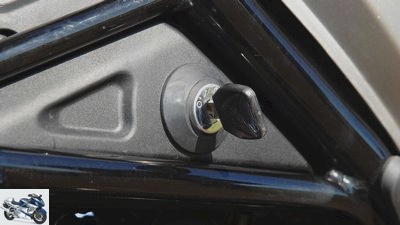
bilski-fotografie.de
5/16
As before, the ignition lock is on the side.
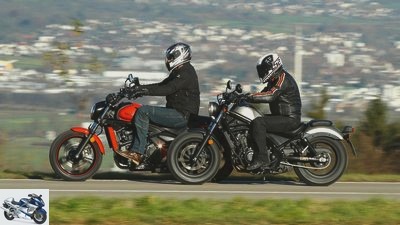
bilski-fotografie.de
6/16
The ranges of the competitors are 30 kilometers apart on country roads. Honda: 303 km; Kawasaki: 333 km. However, the tank content also differs by 2.8 liters.
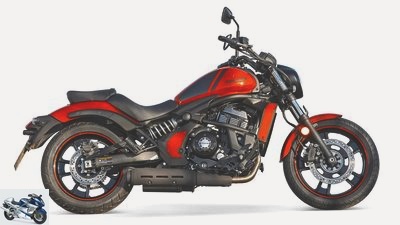
bilski-fotografie.de
7/16
Consumption on 100 km country road drive of the Kawasaki: 4.2 liters.
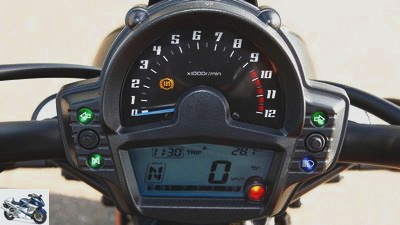
bilski-fotografie.de
8/16
Tachometer, gear indicator, tank filling. The cockpit is reminiscent of the ER-6n.
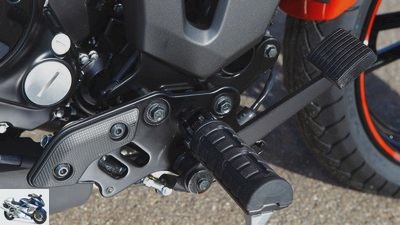
bilski-fotografie.de
9/16
Particularly pleasing: The footrests of the Vulcan are three-way adjustable.
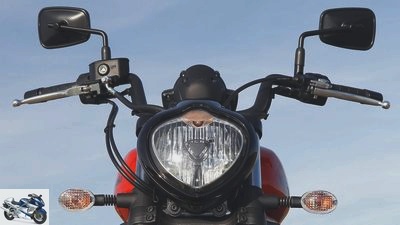
bilski-fotografie.de
10/16
The headlight is more modern with its shape.
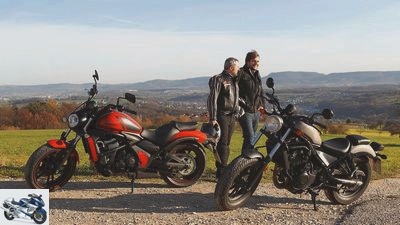
bilski-fotografie.de
11/16
At top speed, the machines meet at eye level. They are specified by the manufacturer as 175 km / h (Honda) and 176 km / h (Kawasaki).
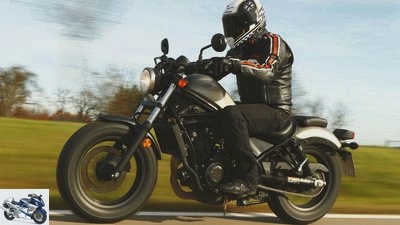
bilski-fotografie.de
12/16
The Honda needed 6.1 seconds to accelerate from 0 to 100 km / h and was left behind in this test.
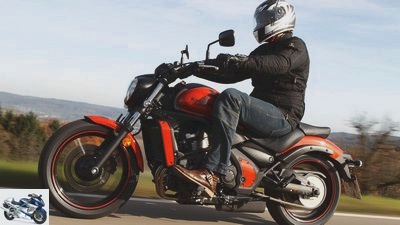
bilski-fotografie.de
13/16
The Kawasaki accelerates from 0 to 100 km / h in 5.0.
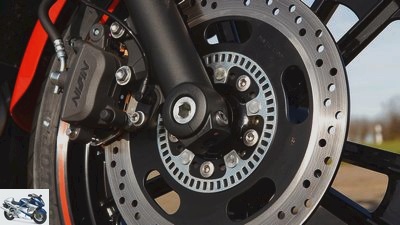
bilski-fotografie.de
14/16
The brakes of both the Kawasaki and the Honda leave nothing to be desired.
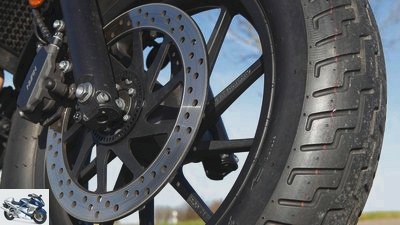
bilski-fotografie.de
15/16
The Dunlop D 404 X mounted on the Honda provides plenty of grip, even on wet roads.
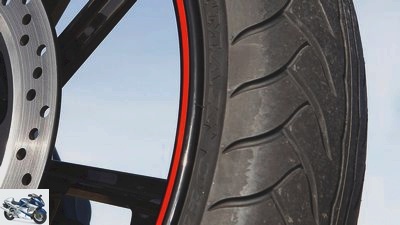
bilski-fotografie.de
16/16
The Dunlop D 220 ST mounted on the Kawasaki provides plenty of grip, even on wet roads.
Compare Kawasaki Vulcan S and Honda Rebel
Japanese choppers in the test
Cool look, roaring two-cylinder sound, airflow and rock ’n’ roll. This is how you imagine a decent chopper. Can the Kawasaki Vulcan S and the Honda CMX 500 Rebel keep up? Which Japanese woman is the most convincing? Both compete against each other on the Swabian Alb.
Right at the beginning, the extremely important ice cream parlor check for entry-level cruisers: Now neither the Kawasaki Vulcan nor the Honda are R.Ebel comparable to the big American bikes à la Harley-Davidson Road King or Indian Chief Vintage. They neither wear a lot of chrome nor do they come with a voluminous, rumbling two-cylinder. Nevertheless, they can convince with their different, independent designs. And: at Kawasaki only the Z 650 and Z 900 sold better than the Vulcan. The Rebel is at least in seventh place at Honda.
Buy complete article
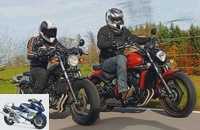
Compare Kawasaki Vulcan S and Honda Rebel
Japanese choppers in the test
No tachometer, no gear indicator
With a long and raised tank, the matt gray paintwork, the headlight and the casual balloon tires, the Honda CMX 500 Rebel lives up to its name. Ignition and steering locks are also really old school. The former was placed on the left between the struts of the front steel frame part, the latter on the lower triple clamp. In the cockpit, the Honda relies on a tried and tested round instrument, at least visually. The round housing houses a rectangular LCD display that provides information on the time, speed and mileage. You won’t find a rev counter or even a gear indicator. With its triangular shape and implied separation from the fender, the single bench fits into the bobber concept. Likewise the two struts. Short front and rear fenders complete the picture. However, the red pencil of the accounting department can also be recognized by some details. Plastic covers were used here and there, for example on the front part of the frame. That doesn’t matter, the overall design is quite coherent.
And yet: The Kawasaki leaves the overall impression of higher quality. The paintwork looks great, especially due to the two-tone design of the tank. The engine’s cooling fins have been milled and give it a more elegant appearance. The covers are made of plastic, but they have been painted orange. With its flat silhouette and wide tank, it clearly stands out from the Honda. For the frame, like the Rebel, she relies on a steel bridge frame. Instead of twin shock, the Kawasaki offers a mono shock absorber on the side.
Kawasaki Vulcan S has 15 hp more
bilski-fotografie.de
The Vulcan is surprisingly agile.
But now off to the country road and give it to him! Is that possible? After all, both bikes do not nominally set new standards. With 46 hp, the Honda Rebel is perfect for A2 license holders. The 471 cm³ in-line twin comes from the CB 500 model range and runs very smoothly. Its performance is particularly suitable for beginners, because it is very predictable and straightforward. However, the engine does not have an excessive amount of torque in the lower speed range and wants to be turned if things go fast, but then ensures driving pleasure for the driver. Its maximum torque of 44 Nm is available at 6,300 rpm. I particularly like the Honda’s gearbox, which shifts extremely smoothly and silently.
The Kawasaki Vulcan S, on the other hand, leaves a much stronger impression thanks to the increased displacement of 178 cm³. It has 15 hp more than its opponent and already produces a torque of 64.3 Nm at 5,700 Nm. Like the Rebel, the Kawasaki is cultivated without attracting attention. At the corner exit she tears nicely and directly makes up a few meters on her opponent. Both bikes have nothing to blame when it comes to cornering fun, because the performance here is significantly less weight than the big bikes from America. The Kawasaki weighs 230 kg with a full tank, the Honda only 193 kg. Move iron pile? Not with the Japanese women. They offer dynamism and pure driving pleasure.
Both motorcycles show their strengths on the Swabian Alb. In terms of agility and handiness, the Vulcan is even untypical for a chopper. It does not show its extra weight and greater mass. The first fast alternating curve holds a special moment on it. With most of the larger, mainly American cruisers, you have the feeling that when you are knocked down quickly you are fighting a fight in which the strongest is inexorably right. With this background knowledge you drive the Kawasaki towards the turn-in point and get shocked. It works so quickly and effortlessly that it would also look good on an athlete. But like most of their guild, the orange green one also reached the end of the lean angle relatively early.
Doubts about the mental health of the testers
The point here definitely goes to the Honda, which has significantly more freedom from lean angles. In contrast to the Kawasaki, it has no fear nipples. The entire notch is used for grinding. The Vulcan should gain a lot of freedom from lean angles once the nipples are ground off. Now one could assume that the chassis of the two would have to be spared too much cornering dynamics. Not at all! Both motorcycles convince with a stability in curves that amazes. And even at high speeds on the autobahn, neither of them twitches or commutes. In terms of driving stability and dynamics, both entry-level choppers definitely deserve their merits.
The brakes of the opponents also leave nothing to be desired. There is no lack of braking power. The ABS on both motorcycles regulates very evenly and gently. The Honda regulates a little earlier, while the Kawasaki requires significantly more manual force from the driver to get into control mode on the front wheel. The seating position of the Honda Rebel takes at least getting used to. There is no real cruiser feeling in the saddle. While the test driver with a body length of 1.72 m describes it as tidy, the author does not really want it to be 1.93 m. He’s sitting more upright. The balls of the feet are almost intuitively placed on the notches that are relatively far back. However, that only slightly reduces the coolness factor when you say: Hand on the gas and the thick and much more powerful cruisers do not leave the rear-view mirrors. Because at the latest in the winding curve, the heavy chunks no longer have a chance, have to admit defeat to the little Japanese women who only have half as much displacement. And straight ahead everyone is probably fast.
Even if the photos suggest picture perfect weather, the temperatures during the test on the Swabian Alb were anything but ideal. The gas station attendant greeted his MOTORRAD customers with horror. There were black ice accidents that morning and he openly questioned the testers’ sanity. At least the thermometer had risen a few degrees by now. It was just still wet.
Passenger – knees under armpits and brace
bilski-fotografie.de
Both undercarriages get along well with two passengers.
In other words, perfect conditions for testing wet grip. You had to be a little more careful to work, but both the Dunlop D 404 X from Honda and the Dunlop D 220 ST donate plenty of grip and confidence. Both Rebel and Vulcan worked perfectly on wet roads. However, the barren pillion seats provided a lot of amusement during the test drive. Swinging quickly onto the CMX 500 to test the driving behavior in pairs and jerk, twitch, the knees are clamped under the tester’s armpits. You sit just as comfortably on most super athletes. The seating position is unsuitable for co-drivers from around 1.70 m, especially for longer journeys. Trying to get my feet on the pegs of the Honda was funny, anyway! These are so high that it was only possible for the admittedly long-standing author to place his feet after a few attempts.
The knee angle is much more comfortable on the Vulcan, but the seat cushion offers little backward support, which means that you slide backwards in the acceleration phase. In order to sit safely while driving, braces are required. In any case, the chassis of both entry-level choppers can cope well with a passenger and can handle the extra weight surprisingly well. A total of two fully developed bikes meet here. The Vulcan snatches the victory. It convinces with its harmonious overall concept, the Honda, on the other hand, with unconditional beginner-friendliness, the cultivated, good-natured engine and a tasty purchase price. Two great choppers that are great fun for little money.
MOTORCYCLE test result
1. Kawasaki Vulcan S.
Overall, the Kawasaki is the more mature motorcycle. It convinces with a comfortable seating position, great workmanship and uncharacteristic driving dynamics. Minuses: It costs significantly more and has a maintenance interval of 6,000 km.
2. Honda CMX 500 Rebel
In terms of driving behavior, high-speed and braking stability, the Honda offers the Kawasaki paroli. It gets more difficult when it comes to performance. Here it is noticeably lagging behind. It has advantages in terms of purchase and inspection intervals.
Kawasaki Vulcan S and Honda Rebel 500 in price comparison
1000PS marketplace app
On the used market you can find both standard and converted copies.
The Honda Rebel 500 and Kawasaki Vulcan S not only convince with good performance and high reliability, but also with their good availability on the used market. If you want compact cruiser fun, you can easily find your next dream motorcycle! The current prices can be found here: used Kawasaki Vulcan S and Honda CMX 500 Rebel in Germany.
Related articles
-
Kawasaki Ninja 300, KTM RC 390, Honda CBR 300 R and Yamaha YZF-R3 in the test
markus-jahn.com 42 photos markus-jahn.com 1/42 Four bikes compete to compare the third-liter athletes. markus-jahn.com 2/42 The Honda fork also responds…
-
Honda VTR 1000 test V-Lenz Spring is all about the new two-cylinder. In the spotlight: Honda’s VTR 1000 F. You didn’t like to read it, those responsible…
-
Comparison test Suzuki SV 650, Honda CB 650 F, Kawasaki ER-6n, Yamaha MT-07
www.bilski-fotografie.de 34 pictures www.bilski-fotografie.de 1/34 They are the hottest candidates among the middle class naked bikes ….
-
Comparison test Honda XL 600 V Transalp against Kawasaki KLE 500
Comparison test Honda XL 600 V Transalp against Kawasaki KLE 500 Silent Stars Never made it big. Others collect prices, they are cheap. Now the …
-
Comparison test Honda CBR 1100 XX against Kawasaki ZZ-R 1100
Honda CBR 1100 XX Super Blackbird comparison test, Honda CBR 1100 XX Blackbird, Kawasaki ZZ-R 1100 Honda CBR 1100 XX versus Kawasaki ZZ-R 1100 Fern, …
-
Honda CB 1100 RS, Kawasaki Z 900 RS and Yamaha XSR 900 in the test
bilski-fotografie.de 31 photos bilski-fotografie.de 1/31 The Honda CB 1100 RS. bilski-fotografie.de 2/31 A feast for the eyes: Visually, the Honda is…
-
Comparison test touring enduro bikes: Honda Transalp, Kawasaki Versys, Suzuki V-Strom 650
Jahn comparison test travel enduro: Honda Transalp, Kawasaki Versys, Suzuki V-Strom 650 Always on the wall, travel enduro does not necessarily mean BMW …
-
Kawasaki Vulcan S, Honda CTX 700 N and Harley-Davidson Street 750
33 pictures 1/33 Kawasaki Vulcan S. 2/33 Kawasaki: Not chic, but functional. Tachometer good, digital speedometer …
-
Comparison test Honda Hornet 600 ABS, Kawasaki Z 750 ABS and Triumph Street Triple
Artist comparison test Honda Hornet 600 ABS, Kawasaki Z 750 ABS and Triumph Street Triple Weekend Warriors Life is almost sterile. Engines…
-
Honda Fireblade SP and Kawasaki ZX-10R in the test
Jahn 44 photos Jahn 1/44 When it comes to price-performance ratio, the Kawasaki ZX-10R can convince more. Jahn 2/44 Bye-bye screwed adjustment rings and…